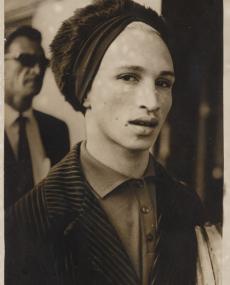
Kewpie was a hairdresser and iconic queer figure from District Six. A gender fluid individual who identified by female pronouns, Kewpie was a seminal nightlife figure who organized balls and celebrations uniting the LGBTQI+ (Lesbian, Gay, Bisexual, Transexual, Queer, Intersex) community with the larger community of District Six.
Her life is one which excavates a hidden archive of local queer lives and culture. Born from the enforced conditions of pre-Democracy South Africa, Kewpie is a seminal chapter in South Africa’s mostly untold queer (her)story.
Born in 1942 as Eugene Fritz, Kewpie grew up in a humble home as one of 6 children. Under the conditions of an overcrowded District Six, only she and two of her siblings grew to adulthood. These same conditions established District Six as a place where a sense of community was foundational to the lives of its people. It was this sense of belonging which gave Kewpie an unapologetic confidence to live her truth.
Kewpie was a natural performer, finding channels for her expressive nature through music, dance and theatre. At the age of 14, her mother enrolled her in ballet classes at the University of Cape Town (UCT). Here she was offered an opportunity to perform overseas. Her father rejected the offer on her behalf, instead setting her up with a salon and encouraging her to pursue hairdressing.
That salon eventually became a cultural hub within District Six; a place to see and be seen. Kewpie used her salon’s popularity to host “Moffie concerts” or drag paegents, which were considered the epitome of drag culture in the 1950s. Kewpie’s balls became so popular within the community that they attracted the attention of local media who would often write about the star power of the drag queens who performed there. This was especially true of Kewpie, who’s stage name Capucine was influenced by her love of vintage glamour. Her impeccable taste informed the creation of a drag persona which would go on to influence the drag of countless queens to follow.
Kewpie established herself as cultural icon for the people of District Six. She was respected by the community despite her consistent challenge to the norm. This was evident when the parents of her long-time partner Brian Armino accepted Kewpie as a woman, welcoming her into their lives. Brian would eventually leave Kewpie to get married and have children. This heartbreaking turn of events emphasizes how, despite wide spread respect, true acceptance for the LGBTQI+ community was yet to be established.
Preceding the forced removals of 1968, Kewpie’s family left District Six for Belville. Kewpie refused to leave her home and the community which she had been integral in fostering.
The eventual disintegration of District 6 left Kewpie deeply depressed. She continued to serve her community into her older years, even after being diagnosed with throat cancer.
Kewpie passed away in 2012, at the age of 71.
Her legacy continues to prove foundational to queer culture in Cape Town. In 2018 her story was given a national stage when the Gay and Lesbian Archives (GALA), together with the District Six Museum, made a collection of over 700 photographs of Kewpie’s life in District Six available to the public. The exhibition, “Kewpie: Daughter of District Six” unearthed an entire archive of local queer history. In 2018, the annual District Six Heritage Day Parade was dedicated to Kewpie and her contributions to the community and culture of District Six. The parade saw GALA and the District 6 Museum collaborate with The Death of Glitter (D.O.G) collective; a group of young queer artists from Cape Town. “Kewpie: Daughter of District Six” toured Johannesburg in 2019.